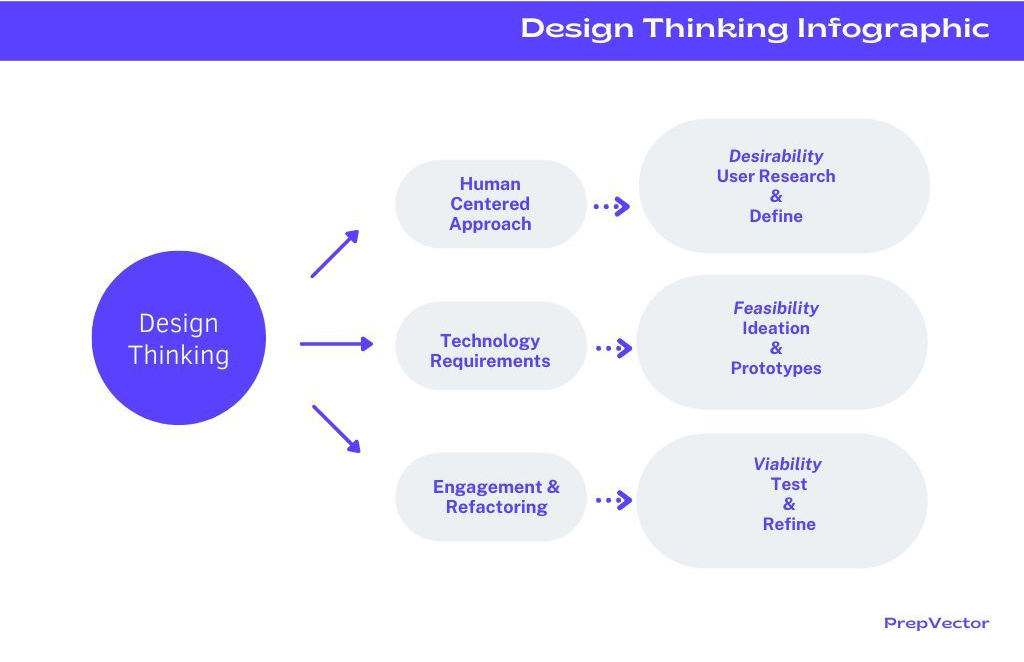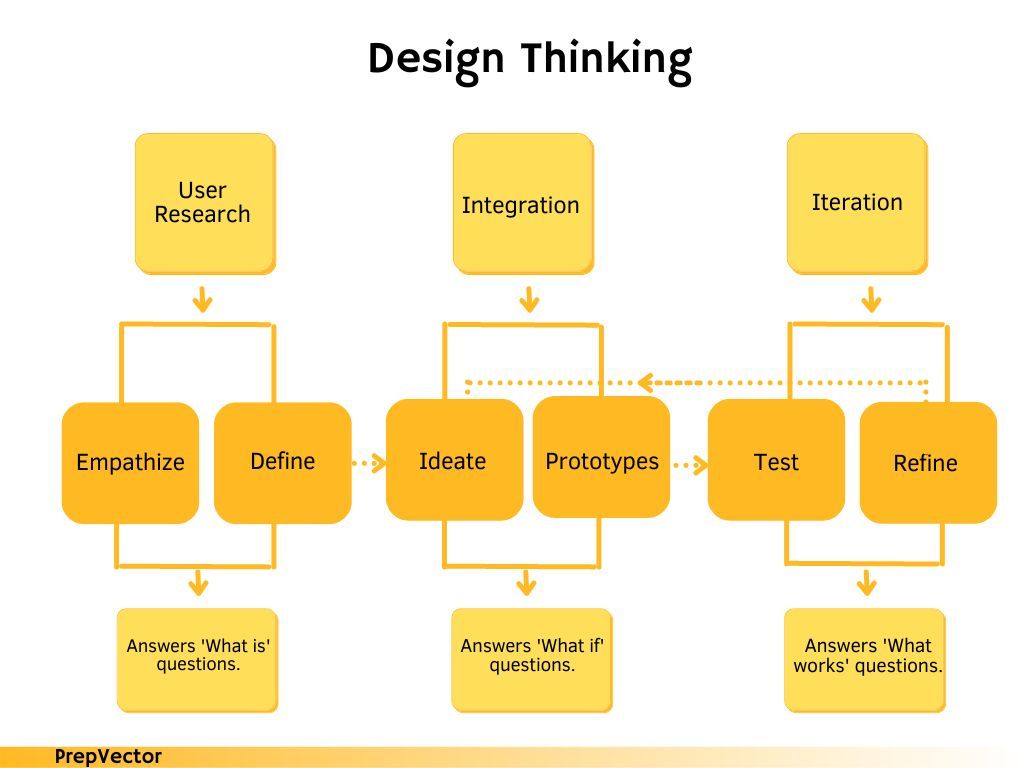Sujithra Gunasekar
Design Thinking
As a product manager, it is important to develop a product that meets the needs of the user. To do this effectively, there are several steps that must be followed, including gathering customer feedback, brainstorming ideas, refining the product, and finally launching it. By addressing issues and flaws early on in the process, the final product is more likely to be successful and cost-effective, which in turn benefits the company's profitability and reputation. To help with this process, a product manager can use the approach of "design thinking" to conduct thorough research and minimize challenges.
Design thinking involves two significant ideas, creative thinking, and a user-first approach. To be more precise Tim Brown, an Industrial Designer who also popularized design thinking explains,’ Design thinking as a human-centered approach to innovation that draws from a designer’s toolkit.’ Developing, processing, and strategizing can have a significant variance like understanding the users well and generating innovative ideas when you think like a designer. To any product manager, finding the wrong solution to a problem that doesn’t cater to user needs is the worst nightmare. But when you are well-equipped with the user’s needs, implement the notion of design thinking. With this approach, you can develop a product that is human-desirable, feasible, and viable both technologically and economically.

The key practice recommended in the process of design thinking is to empathize with the user’s needs. This will reflect ideas that have the potential to solve the problems. Once the user's obsessions are pinned down, the next step is to generate different ways to solve the problem and create a small-scale model that depicts the ideas.
Testing is the next step in the process and once these models are tested, iterating the pros and cons of the product will give the opportunity for further advancement of the product.
By structuring these steps more precisely, we get four levels of action which are:
- Empathize & Define
- Ideate
- Prototype
- Test & Refine
To better understand the steps of implementing design thinking, this blog will analyze and walk you through the steps of design thinking in a software product used worldwide. Amazon is a renowned e-commerce website that initially set its path in 1994 to sell books. But later with the vision to become an online retailer, it took a dynamic leap leading to massive growth in the business.
Empathize & Define
Firstly, empathize with and define the customer’s needs, problems, and expectations towards solving the problems. When you resonate with and expand your understanding of the user, it will help you comprehend the needs more vividly. This is the first step towards building the ideal product: empathize. The next part of step one is to put together all the collected information in one place to further analyze. This part is called defining the customer's needs.
A few ways to optimize this first step are through conducting interviews, making direct observations, or mapping the journey of a product that solves a similar problem.
A few ways to optimize this first step are through conducting interviews, making direct observations, or mapping the journey of a product that solves a similar problem.
In the case of Amazon, it recognized the potential that came with the internet. The users were more comfortable accessing services via the internet which was growing at a very high rate during the early 1990s. Back then, the internet was largely used by academics and the government, but Amazon decided to open it up for everyday users. This was the onset of the global retail website.
Ideate
The next step is to form ideas or conceptions that favor the users for solutions. Ideation leaves room for a realm of possibilities and opportunities. To make this level of action more practical, a traditional approach of brainstorming is initiated. All possible outcomes to the events are noted without any restrictions. A viable action that can be implemented to elevate this process is convergent and divergent thinking. To differentiate, divergent thinking is listing out all the possible outcomes without narrowing them down to a certain stream. From this pool of ideas, figuring out the best approach is known as convergent thinking. Divergent thinking includes all the creativity in finding out many solutions to a single problem whereas convergent thinking relies chiefly on the logic of the solution to solve the problem. Hence this step in design thinking involves a series of creative (divergent) and logical (convergent) thinking.
With Amazon, when the surge of the internet was enormous, it decided from a list of potential mail-order products(divergent thinking) and then decided to sell books (convergent thinking) primarily. By selling books online, the cost to create a physical book catalog was reduced which was an advantage and users were able to access the online catalog more efficiently compared to a physical catalog. This supported the idea of selling books online.
While in the ideation process, a good product manager will also think about the financial needs before converging to the ideal solution. Hence never rush while finalizing the idea, find if there are any possible relevant alternatives if the cost hits the roof.
Prototypes
Prototyping is the process that helps in validating the ideas generated from the previous step. This step is about producing a small-scale version of the final product to identify drawbacks and rectify them in the earlier stages. Prototyping helps in various ways like understanding how the users might interact with the product, finding the complicated aspect and making it more straightforward, bridging the user needs with the appropriate solution, allowing to solve any meager intrinsic problems associated with the product, etc.
Prototyping can be made possible by creating sketches, storyboards, videos, 3D models depending on the product cost margin. Further, a product manager can decide upon building low fidelity prototypes or high fidelity prototypes. A storyboard is an example of low-fidelity whereas a 3D model is an example of the high-fidelity prototype. The difference relies on the expense of building the prototype, and the time taken to build. Making a wise decision with the prototype will cut cost, time and increase the efficiency of the product at the final stages.
Prototyping can be made possible by creating sketches, storyboards, videos, 3D models depending on the product cost margin. Further, a product manager can decide upon building low fidelity prototypes or high fidelity prototypes. A storyboard is an example of low-fidelity whereas a 3D model is an example of the high-fidelity prototype. The difference relies on the expense of building the prototype, and the time taken to build. Making a wise decision with the prototype will cut cost, time and increase the efficiency of the product at the final stages.
Amazon's website, which originally sold books, went public and the books were sold to over 45 countries. We can identify this as the prototype developed for the users by selling only books because prototypes are meant to be short-sighted. If the product faces any unfortunate turnovers in the initial stages, it is more malleable to rectify the error.
Test and Refine
The next two steps in design thinking will help you to remove the redundant elements of the product or replace a complex solution with an easier solution. Once the prototype is ready, it is up for testing. The user test is conducted on the prototype in a natural setting just like a normal end-user would. If there are any difficulties found, it is advised to reiterate the above-mentioned steps to solve the problem. This process of reiterating and redefining the process is referred to as refining. Refining your prototype or working your way up the prototype will help in improving the final results.
Testing should not be restricted to one attempt alone. To identify the behavior of the product with diverse customers, adequate testing scenarios must take place. Make sure testing the prototype answers all the questions that arose during the first phase of the design thinking which is Define and Empathize. If it answers all the questions without leading to any ambiguous answers, then your product is ready to be built and step into the business.
When amazon was welcomed by 40+ countries and the growth in this short span of time was humongous. Understanding that it tested well among the users, they decided to refine and include more products and features to it. Hence, Amazon decided to expand its business from selling only books to selling diverse products and become the world’s largest retailer catering to user needs and renounced its title from a bookseller and became entitled to an e-commerce store. Amazon presently sells over 353 million products including third-party sellers. When the Amazon prototype made a huge difference in the life of the users but was petitioned by other businesses, Amazon decided to refine its idea and rebuild its vision.
Testing should not be restricted to one attempt alone. To identify the behavior of the product with diverse customers, adequate testing scenarios must take place. Make sure testing the prototype answers all the questions that arose during the first phase of the design thinking which is Define and Empathize. If it answers all the questions without leading to any ambiguous answers, then your product is ready to be built and step into the business.
When amazon was welcomed by 40+ countries and the growth in this short span of time was humongous. Understanding that it tested well among the users, they decided to refine and include more products and features to it. Hence, Amazon decided to expand its business from selling only books to selling diverse products and become the world’s largest retailer catering to user needs and renounced its title from a bookseller and became entitled to an e-commerce store. Amazon presently sells over 353 million products including third-party sellers. When the Amazon prototype made a huge difference in the life of the users but was petitioned by other businesses, Amazon decided to refine its idea and rebuild its vision.

Similarly, when you build your product the steps involved during the implementation of the design thinking process are, firstly, empathizing and defining the needs and wants of the user, it is also the ‘what is’ stage of the process. For example, What are the user needs? Next, ideate the possible outcomes with brainstorming sessions that answer the ‘what if’ questions. What if we build this feature to resolve this problem?
Build the prototype to test and refine your product from the feedback received during the prototype testing and this final step will help find the answers to your ‘what works’ questions. Design thinking will help you as a product manager to stay focused on the problem without aberrating from the customer’s needs and build a best-in-class product.
An effective and creative product manager tends to implement this customer-first approach in the path of building the right product. Hence to the skills of a prominent PM, design thinking is a vital skill to master. Mastering this skill will enhance your career and open up a realm of opportunities for your profession.
Build the prototype to test and refine your product from the feedback received during the prototype testing and this final step will help find the answers to your ‘what works’ questions. Design thinking will help you as a product manager to stay focused on the problem without aberrating from the customer’s needs and build a best-in-class product.
An effective and creative product manager tends to implement this customer-first approach in the path of building the right product. Hence to the skills of a prominent PM, design thinking is a vital skill to master. Mastering this skill will enhance your career and open up a realm of opportunities for your profession.

Copyright © 2022
Contact Us!
Got a question? Reach out to us and we will get back to you ASAP!
Thank you!
One more step!
Just a few details before you can download the resources.
Thank you!
Download your resource here
Download your resource here
One more step!
Just a few details before you can download the resources.
Thank you!
Download your resource here
Download your resource here
By submitting this form, you consent to abide by the Privacy Policy outlined by PrepVector.
One more step!
Just a few details before you can download the resources.
Thank you!
Download your resource here
Download your resource here
One more step!
Just a few details before you can download the resources.
Thank you!
Download your resource here
Download your resource here
One more step!
Just a few details before you can download the resources.
Thank you!
Download your resource here
Download your resource here
One more step!
Just a few details before you can download the resources.
Thank you!
Download your resource here
Download your resource here
One more step!
Just a few details before you can download the resources.
Thank you!
Download your resource here
Download your resource here
One more step!
Just a few details before you can download the resources.
Thank you!
Download your resource here
Download your resource here
One more step!
Just a few details before you can download the resources.
Thank you!
Download your resource here
Download your resource here
One more step!
Just a few details before you can download the resources.
Thank you!
Download your resource here
Download your resource here
Access has ended, sorry.
But you can reach out to us at operations@prepvector.com if you need access to the giveaway.
One more step!
Just a few details before you can download the resources.
Thank you!
Download your resource here
Download your resource here
One more step!
Just a few details before you can download the resources.
Thank you!
Download your resource here
Download your resource here
By submitting this form, you consent to abide by the Privacy Policy outlined by PrepVector.
One more step!
Just a few details before you can download the resources.
Thank you!
Download your resource here
Download your resource here
By submitting this form, you consent to abide by the Privacy Policy outlined by PrepVector.

